
Revision Note. We have added some information on the Marvellos' recordings after their appearance on Theron, including a corrected title for their 1958 release on Stepheny. "Boyee Yoing" is now spelled as on the Stepheny label.
Theron Records was formally launched in March of 1952 by Connie Toole, a former railroad employee who had always loved music, and at the rather late age of 43 got into the record business. His label, which recorded a variety of combos, vocal groups, and singers, lasted until 1956. But Toole continued to record into the 1960s. Theron was typical of many Chicago labels of the early 1950s; its recording output reflected both the rhythm and blues and jazz heritage of the 1940s (nightclub acts) and the youth music of the 1950s (doowop groups). So far as we know, no gospel artists appeared on Theron.

Connie Toole was born Samuel Cornelius Toole on August 2, 1909, in Coffeyville, Kansas, the son of two professionally educated parents. Connie Toole and his wife Cleo had three children: Theron, Cornelius, and Jewel. He named the company after his son Theron, who was studying art at the time and designed the labels. Said his other son, Cornelius Toole, an attorney:
After the First World War Chicago became a Mecca for blacks. A lot of people came here to work in the stockyards. And his mother and father came here. His mother was a concert pianist, who had graduated from Chicago Musical College. His father was a lawyer. He had been a bugle player in the Spanish-American War. They divorced in 1925, when he was still a teenager and he grew up in that era during the 1920s. I guess he would be the male version of the flapper.
Toole worked various jobs at United Cigar Company, at the stockyards, and as a messenger for the Post Office. In 1929, when the Regal Theater opened, he was one of the first ushers there. Related Cornelius, "It was a beautiful theater. I can remember when I was five years old getting into the Regal free. Of course, it was loaded with visiting bands. I remember seeing Fats Waller there when I was young. Then my father went on the railroad, the Santa Fe, as a waiter in 1939. My father was extremely interested in the music world. My father played the trumpet and the piano. These musicians used to come by the house all the time and play. I remember Art Tatum coming by our house. He had a passion for the music and for musicians, and the sporting life. He liked that environment, always liked night clubbing and music."
Toole made the record company his life work. First he ran the company out of his home at 5513 Perry Avenue. Later the company had a real business office further south in the heart of the nightclub district, at 6306 South Cottage Grove. The outfit's final address, 500 East 33rd Street, was again Toole's home. Said Cornelius, "he produced all the records for the company, using money he made on the railroad to do it. He put every penny back into the company. That caused conflict in his family, and his wife divorced him. The railroad industry went down after the end of the Second World War, and he couldn't count on that and so he lost his job with the New York Central, the last railroad company he was with. Fortunately through the grace of Congressman Dawson he got a job in the traffic court as a clerk." According to his son Theron, Connie Toole was a popular precinct captain in the Dawson policial organization.
The Theron label operated from March 1952 to early 1956. If every item in the number series was actually released, its total output was 17. We have only been able to trace 13 releases.
A discovery brought to our attention by the late George Paulus—a 78 by Bobby Anderson issued directly out of Modern Recording Studio in Chicago—indicates that Toole had the Theron label in mind earlier, during the last quarter of 1950. The matrix numbers from MRS indicate a date in October or November 1950, but they carry a TH prefix (for Theron) and the notation Tdub. What's more, the compositions on both sides are credited to "Toole." Apparently the plans fell through and it would be more than a year before the first two Theron issues saw the light of day.
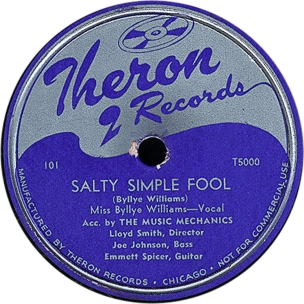
Byllye Williams (voc; p -1); Lloyd Smith (p -2); Emmett Spicer (eg); Joe Johnson (b).
prob. Modern Recording Studio, Chicago, October or November 1950
| T5000 #1 | Salty Simple Fool (Williams) -1 | Theron 101 | |
| T5001 #9 | Hangover Blues (Williams) -2 | Theron 101 |
Theron 101—mislisted as T-5001—was announced in Billboard on March 1, 1952, p. 31. It was reviewed (as Theron 101) in Cash Box on March 8 (our thanks to Dan Kochakian for a clipping). The first record Toole put out by pianist/vocalist Byllye Williams got considerable play in Chicago. We would very much like to know the original matrix numbers, which we strongly suspect derived from Modern Recording Studio at 55 West Wacker Drive; the T5000 series numbers that appear on the records aren't very informative. However, the #1 and #9 after the T series numbers in the vinyl could be take numbers. In fact, since two sides by Byllye Williams and (probably) three by Bobby Anderson were recorded with the same backup, we suspect they came from the same session.
Lloyd Smith is credited as the pianist on "Hangover Blues." Despite the title, it is a minor-key composition that was probably not in Byllye Williams' nightly repertoire before the session. Smith is listed as "director" on "Salty Simple Fool" where the blues piano is obviously Byllye's own.
By 1950, Byllye Williams was a veteran of the city's nightclub world. She was a piano-bar stylist who entertained with a mixture of pop tunes, jazz, and blues. Byllye Williams was born Byllye Elizabeth Blassengame on April 13, 1922, in Dowagiac, Michigan. Her family had moved to Dowagiac from Chicago, then returned to the city at some point during her childhood. Her father was a minister, and it is plausible that she got her early piano training playing gospel hymns in church. She joined Local 208 of the Musicians Union in Chicago on November 4, 1940. At the time, she gave her name as Byllye B. Williams (which could be a stage name).
Williams first attracted notice in the spring of 1941 performing at Fay's Rose Bowl (655 East 43rd—she was described as "famous blues singer") and then at the Piccadilly Inn (3652 Indiana—she was billed as "sensational torch singer" and "one of the city's leading vocalists"). On February 19, 1942, her contract with Tin Pan Alley, a Loop establishment, was accepted and filed by Musicians Union Local 208. She was back at Tin Pan Alley for an "indefinite" engagement starting in September (contracted accepted and filed on the 17th). Later that fall she was performing nightly at Don's Den (528 East 43rd St), owned by former grid star, Don Simmons (her contract with Simmons was posted on November 5). The Defender ran her picture and in the caption described Williams as "one of the city's finest pianists and song stylists." During much of 1943 she played at the Piccadilly Inn and Don's Den. She also appeared at the Sunny Side Club (contract accepted and filed August 19, 1943); however, she was back at Don's Den in October (contract posted on October 21). On June 1, 1944, she posted a 1-week contract at the Show Tap; on July 20, she posted a contract for 8 weeks at Millie's Cocktail Lounge; her contract was extended on August 3 and again October 19. On November 16, she posted a 4-week contract at the Flame Lounge (3020 Indiana). Thereafter, until she made her first two recording sessions in 1947 for Opera, she performed at such nighteries as The Flame, the Casablanca Lounge (3901 South Parkway), Cafe de Society, and the 708 Club (708 East 47th).
From 1948 to 1952 Williams continued her busy club schedule, performing at the Four Star Lounge (224 East 61st), two gigs at El Morocco (3933 Drexel) with Little Sax Crowder and then with Claude McLin, at Millie's Lounge (on 43rd), at the 113 Club (June 1950), at the L-Bow Lounge (August 1950), and at Harry's Show Lounge (in October 1951). In early 1952 she was working Cadillac Bob's Flame Show Bar (809 East Oakwood). Cadillac Bob's establishment was in the basement of the Morocco hotel—it was a successor to El Morocco and had no connection with the old Flame Lounge.
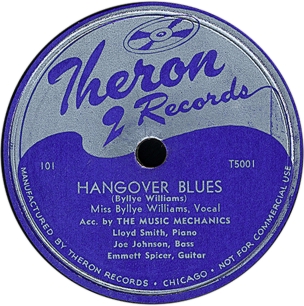
After "Salty Simple Fool" finally saw release, Williams continued her nightclub work, much of it in Loop spots (i.e., white nightclubs), according to Chicago Defender reports in 1953 and 1955. In June 1952 she posted contracts with the Tropical Knight Lounge and O'Brien's Tap (both were accepted and filed by Local 208 on June 19).
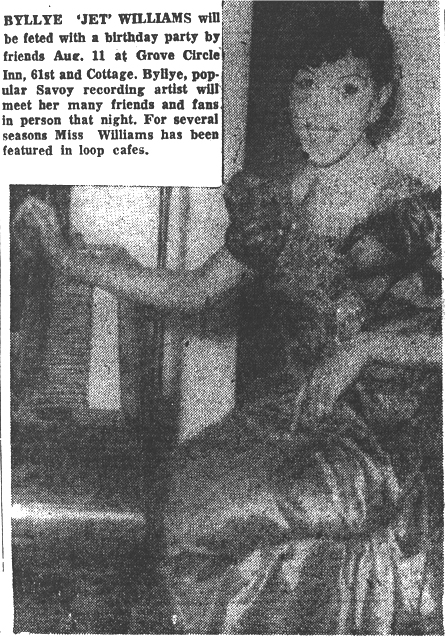
In 1953, the Defender reported her having recorded for Savoy, and performing at the Grove Circle Inn (61st and Cottage Grove). The Savoy recordings actually dated from 1947; they had been purchased from Opera when the company went out of business in October 1948, and were subsequently released on Savoy and its subsidiary, Acorn. Williams apparently picked up her nickname, "Jet," in 1953; thereafter it appeared as her middle name in all references to her. (She was so attached to it that it showed up on her death certificate.)
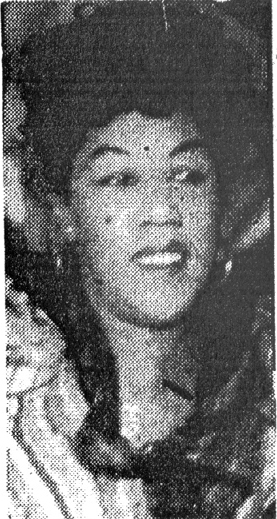
Subsequently, Williams performed at Duke Slater's Vincennes Lounge (601 East 36th) in 1955, The Casbah (6109 South Parkway) in 1956, McKie's Disc Jockey Lounge (6325 South Cottage Grove) in 1957, and Harry's Cocktail Lounge (432 East 63rd) in 1958.
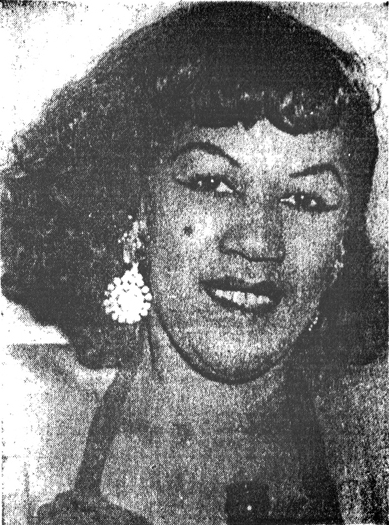
During the second half of 1957 and the beginning of 1958, Byllye Williams was starting to get more publicity in the Defender again. Sadly, it wouldn't last.
By April 1958, she was too ill to work, and she died on November 4, 1958, of cancer of the cervix. According to her death certificate, her married name at that time was Byllye Laskaitis. At the end of her 18-year career, the Musicians Union had to be talked into contributing to her burial expenses.
Mrs. Vivesta Mitchell, 610 West 60th Street, appeared before the Board, advising that her daughter, Byllye Williams died at the County Hospital, November 4, 1958. Mrs. Mitchell had previously been advised by President Gray that her daughter had been erased for non-payment of dues since April 1, 1958.
Mrs. Mitchell informed the Board that she knew she was not entitled to anything as the beneficiary of her daughter, but she explained that there was no money for burial and tentative arrangements had been made with the undertaker for a $500 burial with a down payment of $200 of which she had $60. She asked the Board to make a donation.
The Board discussed the matter at length and on motion, ruled that Miss [sic] Mitchell be given a donation of $100. (Local 208 Board meeting minutes, November 6, 1958, p. 2).
We obtained much of Byllye Williams's recording history from Leadbitter, Fancourt, and Pelletier's Blues Records, 1943-1970 Vol. 2, L-Z and her club information from Chicago Defender ads and Board minutes for Musicians Union Local 208 (now preserved in the Chicago Public Library). The Musician Death Files and the Local 208 Board meeting minutes from the Chicago Federation of Musicians (now housed in the Chicago Public Library) were an invaluable source of biographical information.
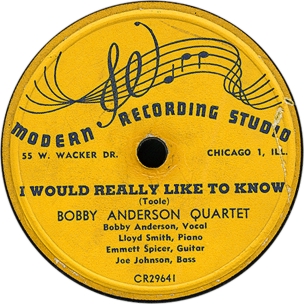

Bobby Anderson (voc); Lloyd Smith (p); Emmett Spicer (eg); Joe Johnson (b); Connie Toole (arr).
Modern Recording Studio, Chicago, October or November 1950
| TH29641*, A-13691* | I Would Really Like to Know (Toole) | Modern Recording Studio CR29641* | |
| TH29642*, A-13692*, T-5003 | I Would Rather Stay Home with Your Picture (Androzzo) | Modern Recording Studio CR29642*, Theron 102 | |
| T-5002 | S'posin' (Denniker-Razaf) | Theron 102 |
Bobby Anderson was a ballad singer, and according to Cornelius Toole, he originally hailed from Atlanta. He had been working for years in the Chicago Post Office when Connie Toole discovered him.
Courtesy of Tom Hudgins, who has generously provided scans from the collection of Charles Billante, we know that the same trio appeared on Theron 102 as on Byllye Williams' "Salty Simple Fool." They were not billed as "The Music Mechanics," however. The labels to Theron 102 inadvertently left Bobby Anderson's name off the side with "I Would Rather Stay Home with Your Picture." Emmett Spicer's name is also misspelled on that side.
George Paulus turned up a limited-edition pressing of two tracks from this session on the Modern Recording Studio's own label. The issue number is the same as the matrix number in MRS's system; interpolation between recordings that were made for Seymour in September 1950 and a Claude McLin session for Chess gives us October or November 1950 as the date (earlier than we previously realized that Connie Toole was trying to get into the record business). There is no question about Toole's involvement with this MRS 78; he is listed as the composer for both tunes (incorrectly, in the case of "I Would Rather Stay Home with Your Picture") and the matrix numbers in the vinyl carry the prefix "TH" for Theron. Not to mention the further notation "Tdub" on both sides... The 78 also carries matrix numbers in the A-13600 series previously known from items that were recorded during the same period at MRS for Seymour and subsequently sold to Discovery Records of Los Angeles. However, we have uncovered no evidence of a business relationship between Connie Toole and Seymour Schwartz, or of Toole's participation in the Discovery deal.
We are assuming that "I Would Rather Stay Home with Your Picture" is the same version on the MRS and Theron 78s—but it wouldn't hurt to hear the Theron release so we could make the comparison. Toole may have changed the coupling (from "I Would Really Like to Know" to "S'posin'") to avoid issuing a record with two similar-sounding ballads on it.
"S'posin," which was arranged and produced by Toole, got a considerable response and encouraged Toole to continue in the record business. Written in 1929 by composer Paul Denniker and celebrated lyricist Andy Razaf, "Sposin'" was originally a hit for crooner Rudy Vallee. In 1936 it was given a memorable jazz rendition by Fats Waller, which Toole no doubt knew. And the song remained commercially viable; it would be back on the pop charts in 1953, when Italian-American singer Don Cornell enjoyed some success with his version. Years later Cornelius Toole's son, a film student in college, used "Sposin'" as part of a soundtrack for a film project.
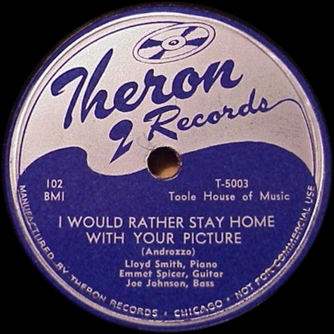
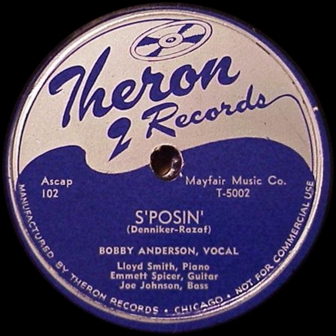

Byllye Jet Williams (voc*); Dudley Emmons (voc§); Leon Washington (ts, ldr); other musicians unidentified.
Universal Recording Chicago, c. October 1953
| U-2628 | I'm So Lucky (B. Williams)* | Theron 103 | |
| U-2629 | Baby I Don't Love You Anymore (R. Williams)§ | Theron 103 | |
| ? | I'm Just a Fool (Toole)^ | unissued | |
| ? | Hanging Around (Toole)^ | unissued |
There was a hiatus in Theron's operations from the second half of 1952 on into 1953. Since the matrix numbers to Theron 103 are in a series that Universal Recording used for sessions by Chance, JOB, and other small labels, we can give the session an approximate date. Matrix numbers U2602 through 2613 come from two sessions that JOB recorded on October 5, 1953.
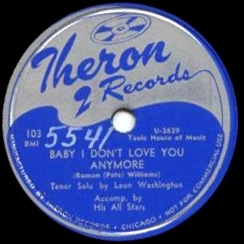
Theron's third release did not appear until February 1954, when Billboard gave it a review (February 20, 1954, p. 42). With regard to the instrumental number, the scribe wrote, "Washington does a good job on tenor, while the ork supports him quietly on this pretty ballad." The reviewer gave it a 69 rating. On the flip, the reviewer said, "Washington hands this jump tune a bouncy reading that could interest jazz fans, while thrush Byllye Jet Williams turns in an old-fashioned jump reading," but gave the side a staggeringly low 55 rating. Billboard ratings partly measured commercial potential. This meant that the size of the company was taken into consideration, and Theron was terribly small. Generally, if a rating was in the 60s the record was below average. A recording that usually gathered an upper 60 rating on an indie label, would garner a rating in the mid to upper 70s if released on a major label.
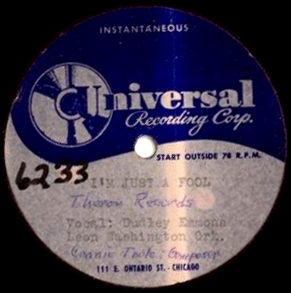
Two sides by singer Dudley Emmons with the Leon Washington Orchestra turned up recently on a test pressing from Universal Recording. We have placed them on this session because it was the only one that Toole is known to have done at Universal, and they round the session out to the accustomed four sides.
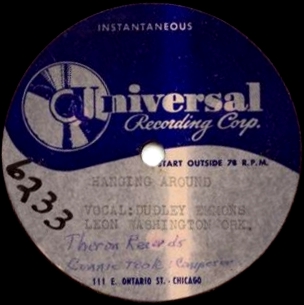
With this session, it is apparent that Toole has began to rely on two mainstays in the Red Saunders orchestra, tenor sax player Leon Washington and pianist Earl Washington. Contrary to some reports, Leon and Earl were not related.
The tenor saxophonist was born Leon Diamond Washington on June 27, 1909, in Jackson, Mississippi. The Washington family moved to Chicago when Leon was a very young child. Upon graduation from Tilden Tech in 1926, he immediately began a professional career in music, joining the Edward Carry Band, and then traveling in a band led by pianist Zinky Cohn. He then joined Bernie Young and his Creolians. Leon Washington made his first recording in 1930 with Frankie Franko's Louisianians. With Franko, Leon played alto sax, but he eventually switched to tenor; his main man on the larger instrument was obviously Coleman Hawkins. On August 11, 1934, the Chicago Defender mentioned Leon Washington (on "saxophone") as a member of Carroll Dickerson's house band at the Sunset Café (see Jack Ellis's column "The Orchestras"); he remained in the band at this noted black-and-tan until some point in 1935.
Next Leon Washington joined Louis Armstrong's big band, and in 1936 he began playing in the Fats Waller band. In 1937 he joined the legendary Earl Hines band at the Grand Terrace, recording with Hines on a session in 1938. In July of that year he moved to join the Red Saunders band at the Club De Lisa. He was on Red's first recording session as a leader in December 1945, and made nearly all of Red's sessions thereafter. Washington stayed with Saunders until 1963, when he became Assistant to the President of the partly merged Local 10-208 (the merger was not complete until 1966). He stayed on that job until his death from leukemia on February 19, 1973.
Basic facts on Leon Washington came from the death certificate, funeral program, and other documents found in the Leon Washington file in the Musicians Union Death File collection at the Chicago Public Library.
The pianist was born Earl Edward Washington in Chicago on April 3, 1921 and was raised in the city. He grew up in the small black section of the Morgan Park community in far southwestern Chicago, and graduated from Morgan Park High School. He then attended the Chicago and Boston Conservatories of Music. After service in World War II, he joined the Musicians Union Local 208 on November 15, 1945; at the time he lived at 1302 West 112th Place. He joined Red Saunders in 1947, around the time of Red's return to the Club DeLisa, and remained until the early 1960s. His sister Ella married a brother of Red Saunders. After Theron, Earl Washington recorded a single as a leader for Federal, which was picked up by Checker (Checker 905, with a couple of R&B instrumentals, was reviewed in Cash Box on October 22, 1958, p. 50). In the early 1960s, he made a couple of jazz singles for Formal and an LP for Jazz Workshop. After leaving the Saunders band, he worked with bands that played the Blue Note, the Gaslight Club and the Playboy Club—all top-rated North Side establishments that catered mostly to White audiences. Earl Washington died of a heart attack in Chicago on June 16, 1975. The Chicago Defender ran an obituary on June 19, 1975, from which we were able to learn some facts about his life.
We obtained the basic facts on Earl Washington from his membership card and the death certificate found in the Earl Washington file in the Musicians Union Death File collection at the Chicago Public Library.
The Saunders aggregation was the top show band in town, and a good jazz band when it got the opportunity to be one; the Washingtons were well-suited to the earlier forms of R&B, but the advent of rock and roll left them sounding dated. Younger saxophonists like Red Holloway, Harold Ashby, Cliff Davis, Harold Ousley, and Little Wash were landing most of the R&B session work in the mid-1950s, which may explain why Leon ended up allying himself with a small operation like Theron. Meanwhile Earl might get an occasional call from Vee-Jay, but most of the session piano work there was going to Horace Palm, Norman Simmons, or Turk Kincheloe (aka Kirk Stuart).
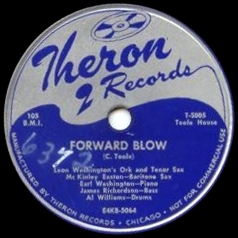
Leon Washington (ts); McKinley "Mac" Easton (bars); Earl Washington (p); James Richardson (b); Al Williams (d).
RCA Victor Studios, Chicago, 1954
| T5006 (E4KB5063) |
Blue Mambo (Doris Jones) | Theron 105 | |
| T5005 (E4KB5064) |
Forward Blow (C. Toole) | Theron 105 |
As with the previous release by the Washingtons, despite the excellent performances there was no market for this act's jazz stylings. Copies of this single in the collections of Yves François Smierciak and Dr. Robert Stallworth are our source of information (the personnel is listed on the "Forward Blow" side). Both sides are superior jazz instrumentals, with strong solo work by Leon Washington, Mac Easton, and Earl Washington; they are overdue for inclusion in a collection of the best Chicago jazz of the period. The matrix numbers in the vinyl indicate that the single was mastered and pressed by RCA Victor in Chicago; the E4 prefix signals 1954.

Although Leon Washington performed on several other Theron recordings, Theron 103 and 105 are his only releases as a leader.

Little Joey Jones, Jr. (voc) accompanied by the Aquila Orchestra: personnel unidentified.
poss. RCA Victor Studios, Chicago, 1954
| 5007 (8153-1 C45B) |
The Spaghetti Has Bones | Theron 106 | |
| 5008 (E4KB 8154-1) |
Sweet Tooth Blues | Theron 106 |
On July 9, 1955, a Little Joseph Jones, Jr. from Chicago passed the singing tryouts at the Apollo Theater in New York City. By March 1956 he had a record on another label, titled "The Polio Song," which was supposedly about to be released. Joe, who is only 9 years old, is a coming guitarist, and since he began singing at the age of two, has shown remarkable progress toward professionalism" (Ted Watson, "Young Guitarist Is Going Places," Pittsburgh Courier, March 24, 1956, p. A35). We have no information on the Aquila Orchestra. The E4 prefix indicates a 1954 mastering and pressing job by RCA Victor in Chicago.
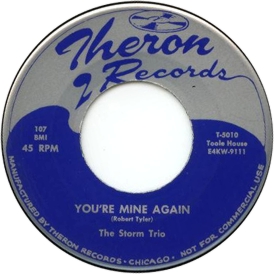
Unidentified female vocalist; two unidentified male vocalists; unidentified p, eg, eg, b.
RCA Victor Studios, Chicago, 1954
| T-5009 (E4KW-9112) |
Cause You're My Lover (G. Tyler-S. Feller) | Theron 107 | |
| T-5010 (E4KW-9111) |
You're Mine Again (R. Tyler) | Theron 107 |
Theron got no reviews from trade magazines for these tracks. The songwriters listed on the label (G. Tyler, Robert Tyler, and S. Feller) might be a clue to the identity of the combo. Vocally, the group consisted of a female lead singer and two male singers. The instrumentarium on each side consists of piano, two electric guitars, and string bass. The piano parts are sparse and could have been overdubbed; we assume that the trio members were also responsible for the instruments.
"Cause You're My Lover" is a perky white pop tune; there is a decent guitar solo on it, played by someone with jazz experience. "You're Mine Again" is a sentimental lounge ballad that also leaves room for a guitar solo; in this case the guitarist is a mite too decorous.
Again, the E4 series matrix numbers indicate mastering and pressing (and most likely recording) by RCA Victor in 1954.
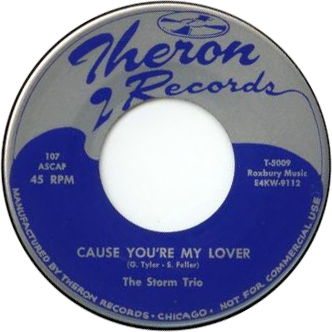

The Ebony Moods: poss. Louise Baker (lead voc); two unidentified males (voc); accompanied by Earl Washington (p); unidentified (eg); unidentified (b); unidentified (cga, claves -1).
RCA Victor Studios, Chicago, 1955 (two sessions)
| T-5011 (F8OB-1049) |
I've Got News for You (L. Baker) | Theron 108, Sabre SA-110 [bootleg EP] | |
| T-5012 (F8OB-3558) |
Grand, Nice, Swell (L. Baker) -1 | Theron 108 |
The second vocal group that Toole recorded was the Ebony Moods, at two different sessions in the first half of 1955. The Moods sang in an archaic 1940s style that wasn't going to sell at this date. The group was a female-led male ensemble, and both sides were written by one Louise Baker, who may have been the lead singer.
Like the Storm Trio, the Ebony Moods consisted of a female lead singer (alto instead of soprano this time around) and two male vocalists. This however, was a much hipper ensemble. And the musical backing is superior, as we might expect with Earl Washington at the helm. "I've Got News for You" features an excellent jazz guitar solo (we're not sure who it is). "Grand, Nice, Swell" sounds too close to "'SWonderful" for comfort, but the mambofication is interesting. Earl Washington supplies the mambo piano solo, the guitarist gets a second outing, and a Latin percussionist is added.
The record got a belated but generous review in Billboard in October of 1955. Regarding "I've Got News for You" (which got a 73 rating), the Billboard reviewer said "mixed group does a relaxed appealing performance. Gal Singer, who carries the lead, has quality." On the flip (which got a 72 rating), the reviewer said, "has a lilt and a Latin beat. Pleasant chanting."
Judging from the matrix numbers (which indicated that the records were mastered and pressed by RCA Victor—maybe also recorded at the RCA Victor Studios on Navy Pier—while the "F" prefix marks 1955), the accompaniment on both sessions was by the brothers Washington. According to Robert D. Ferlingere, A Discography of Rhythm & Blues and Rock 'n Roll Vocal Groups, 1945 to 1965(2nd edition, 1992), there are West Coast "repros" of this single on black vinyl.
A distinctly weird bootleg reissue of the Ebony Moods took place at an unknown date on Sabre 110, a 45 rpm EP. "I Have News for You," as the title goes, is the first item on Side A. It is followed on Side A by "Drink Wine Spoodeodee" (Wynonie Harris); Side B consists of "I'm Just a Ladies Man" (Jimmy Witherspoon) and "Feelin So Sad" (Joe Turner). Our thanks to Konrad Nowakowski for alerting us to this bootleg, a copy of which is in his collection (titles are spelled as per the label on the boot). The boot has absolutely nothing to do with the real Sabre operation, which was a subsidiary of Chance.
Despite the favorable trade press, the record probably languished in boxes at the distributor.
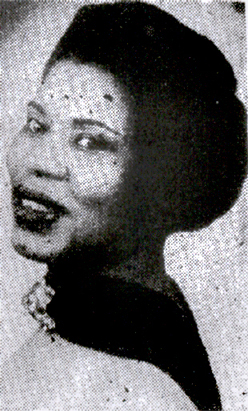
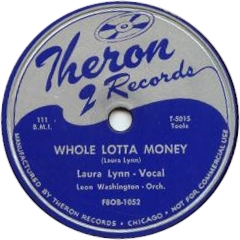
Laura Lynn (voc); Leon Washington (ts); McKinley Easton (bars); Earl Washington (p); unidentified (b); unidentified (d).
RCA Victor Studios, Chicago, 1955
| T-5015 (F8OB-1052) |
Whole Lotta Money (Lynn) | Theron 111 | |
| T-5016 (F8OB-1051) |
I'm Just a Fool (Toole-James) | Theron 111 |
Connie Toole seemed to have a soft spot for female vocalists. Laura Lynn had been performing in local clubs for a couple of years, most notably at the Flame Show Bar (809 East Oakwood) and the Cotton Club (6249 Cottage Grove) in 1953. She also played congas, though these are not heard on her session for Theron, where she is accompanied by what had become Toole's house band, Leon Washington and group.
"Whole Lotta Money" is a solid R&B number. It features a nice baritone sax solo (obviously by Mac Easton) as well as good tenor solo by the bandleader. "I'm Just a Fool" is the standard ballad B side. Laura Lynn gets a little wavery in her bottom register, but the accompaniment is sensitive and Leon does his Hawk thing on tenor sax. This is probably the same song that Dudley Emmons recorded back in October 1953, in a version that Toole left unissued.
Since the first Ebony Moods track was cut at this session, and Earl Washington was responsible for the piano on it, we are reasonably confident that he also backed Laura Lynn.
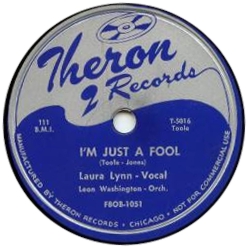
Laura Lynn continued to perform in South Side clubs during 1956 and 1957. After that, we lose track of her.
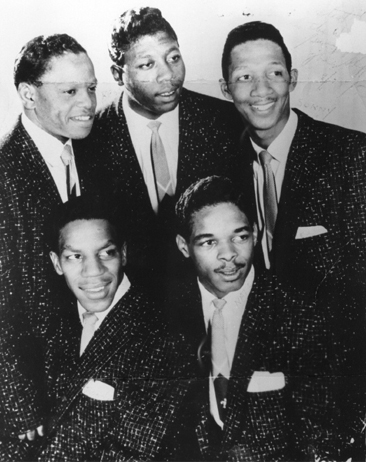
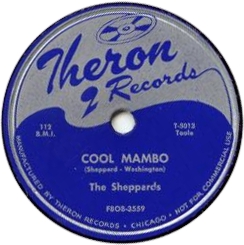
The Sheppards (voc): John Pruitt (tenor and lead -1); James Dennis Isaac (first tenor -1); Nathaniel Tucker (bass -1); George Parker (baritone and lead); Oscar Boyd (second tenor -1) with Earl Washington (p); Leon Washington (ts); unidentified (b); unidentified (d).
RCA Victor Studios, Chicago, 1955
| T-5013 (F8OB-3559) |
Cool Mambo (Sheppard-Washington) | Theron 112 | |
| T-5014 (F8OB-3560) |
Love (Sheppard-Washington) -1 | Theron 112 |
The Sheppards shared this session with the Ebony Moods (see above) and Earl Washington (see immediately below).
In the summer of 1955 Toole put out an appealing ballad on the Sheppards, "Love," using as accompaniment his session band led by Earl Washington. "Love," featuring tenor John Pruitt on lead, was a bit "deep" for that year and scored no sales action. The side features a brief but effectively brooding solo by Leon Washington in his best Hawkins manner; Leon also gets the coda.
"Cool Mambo" was a slow Charles Brown-styled blues with a Christmas theme (the title hinted at its unseasonable subject). It featured Parker as a solo vocalist with no chorus. The musical accompaniment with Earl's tinkling keyboard work and Leon's smooth mellow noodling was lovely. How the mambo reference got attached to this Blue Christmas number is a mystery to us—there is no discernible Latin beat. After Earl's piano intro, Leon accompanies the vocal, and Earl quotes "Jingle Bells" in his piano coda.
The Sheppards, who at this time were playing such upscale spots as the Club DeLisa, were not recording doowops for teenagers with this release. By the end of 1955, the Sheppards had moved to Leonard Allen's United label.
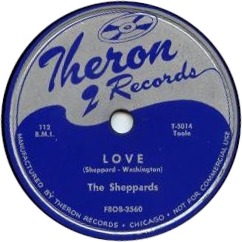
Our information on the Sheppards came largely from a Robert Pruter interview with various members of the vocal group. Their story was published in the book, Doowop: The Chicago Scene (1996).
According to Robert Ferlingere's Discography of Rhythm & Blues and Rock 'n Roll Vocal Groups, 1935 to 1965 (2nd edition, 1992, there are East Coast "repros" of this single on red vinyl, and other East Coast "repros" on vinyl in 6 colors.
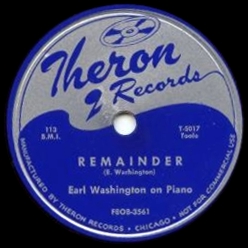
Earl Washington (p); unidentified (b); unidentified (d).
RCA Victor Studios, Chicago, 1955
| T-5017 (F8OB-3561) |
Remainder (E. Washington) | Theron 113 | |
| T-5018 (F8OB-3562) |
Baia (A. Barroso) | Theron 113 |
The Billboard reviewer in the October 22, 1955, issue gave "Baia" a 72 rating and "Remainder" a 70 rating. On "Baia" the he said "good piano work on this Latin instrumental; it's full of beat and atmosphere, and on "Remainder" the comment was "piano instrumental has interesting harmonies and catches a mood." These reviews were not shabby for a small independent label.
These two instrumentals were done at the end of the Sheppards sesssion, which also included one track by the Ebony Moods. We presume that on "Baia" the conga and claves that can be heard on the Ebony Moods side made their reappearance.
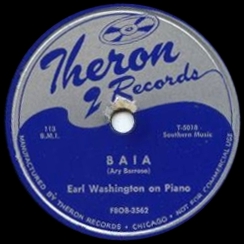
Earl Washington did not sing on this record. Yet Lord's Jazz Discography credits him with vocals only!
This single was the first record that Earl Washington released under his own name. After Theron went inactive, he cut four tunes for Federal/King on June 11, 1958; these were later sold to the Chess brothers, who put out "Miserlou" and "Wolf Call" on Checker 905. The lineup on them consisted of Washington (p), Johnny Avant (tb), Cliff Davis (ts), Mac Easton (bars), Lefty Bates and Leo Blevins (eg), unidentified (b), and Vernel Fournier (d)—not too shabby. But at the time record companies thought any performance that was stiff and loud with little dynamic variation would pass for rock and roll. Earl Washington was pretty busy in the studios in 1960. In June of that year he cut 5 tracks for Formal Records with the Earl Washington All Stars, who included Basie-ites Thad Jones (cornet), Benny Powell (tb), Frank Foster (ts), Frank Wess (fl), Eddie Jones (b), and Sonny Payne (d); he also cut at least one track for Formal that year with Johnny Avant (tb), John Neely (ts), Herbert Brown (b), and Walter Perkins (d). He was further responsible for 6 sides with a trio that included Israel Crosby (b) and Vernel Fournier (d), and 2 blues sides with Paul "Guitar Red" Johnson plus an electric bassist and drummer. In 1962, Earl Washington cut his final session for Formal with a group that included blues singer Joe Buckner. Many of the sides he cut for Formal were reissued on a label called Jazz Workshop (not the same as the company owned by Charles Mingus).
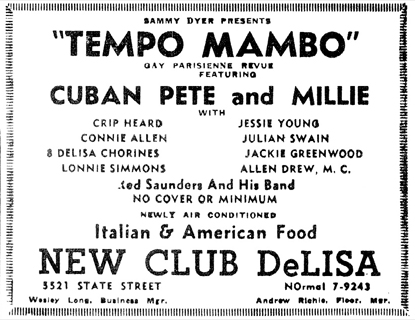
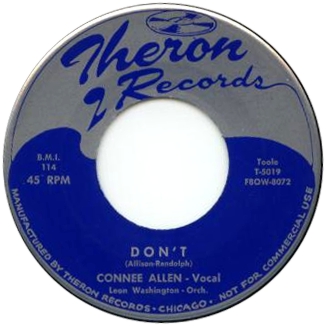

Connee Allen (voc); Leon Washington (ts); prob. Earl Washington (p); unidentified (b); unidentified (d).
Chicago, c. August 1955
| T-5019 (F8OW-8072) |
Don't (Allison Randolph) | Theron 114 | |
| T-5021 (F8OW-8073) |
What Jolly Folks (V. Tunney) | Theron 115 | |
| T-5022 (F8OW-8074) |
Saving My Love (S. Johnson) | Theron 115 | |
| T-5020 (F8OW-8075) |
I Haven't Got the Heart (Allison-Alangi-Toole) | Theron 114 |
Connee (also spelled Connie) Allen was a native of Detroit. In June 1951 she took over from Kitty Stevenson as Todd Rhodes' vocalist; she first appeared on record on Rhodes' "Rocket 69," "Possessed," "Your Daddy's Doggin Around," and other tracks released on King. Early in 1952 she left Rhodes and was replaced by LaVern Baker. Allen played Chicago clubs on occasion, most notably the Club DeLisa, where she performed in April 1955, with a return engagement in August. This was the point at which Connie Toole apparently decided to record her. The Defender described her as a "blues stylist."

There is some variety on her session for Theron, the label's third outing at RCA Victor Studios in 1955. "Don't" features her contralto voice on a catchy R&B number, though we wish she didn't sound so perfunctory in the stop-time vocal passage. The accompaniment is a bebop blues—another reminder that Leon and Earl had grown comfortable with many styles while working 6 nights a week with Red Saunders. Leon and Earl both solo.
"I Haven't Got the Heart" is the obligatory ballad, but Connee Allen gives it close to a Country delivery. Leon does his Hawk thing again.
"What Jolly Folks" is a cutesy uptempo song with a definite Country influence. There are no instrumental solos but Leon is prominent in the accompaniment.
"Saving My Love" is a bluesy ballad with a monologue inserted. As "Saving My Love for You," it had been a hit for the short-lived R&B singer Johnny Ace in early 1954. Leon is featured in the coda.
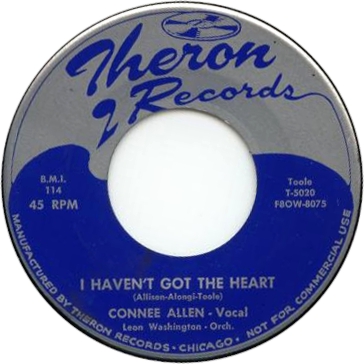
Theron 114, "Don't" b/w "I Haven't Got the Heart," was released in October of 1955; the Billboard review gave the sides 71 and 70 ratings respectively. On "Don't" Billboard said, "nice blues side, with smart lyric and good performance by Miss Allen," and on the flip the trade pub said, "Connee Allen displays a voice of interesting quality in this pop-styled ballad." Toole apparently did well with Billboard that October, getting three reviews out of the trade publication. Toole aggressively pushed her records into the new year; for instance, in an ad for Theron 114 in Cash Box, which reviewed the record in the same issue (January 14, 1956, review on p. 36, ad on p. 37). While he was doing the Cash Box promotion (January 14, 1956, p. 33) she was singing at El Sino, in Detroit. Despite Toole's enthusiasm for his Connee Allen discs, he could not launch her.
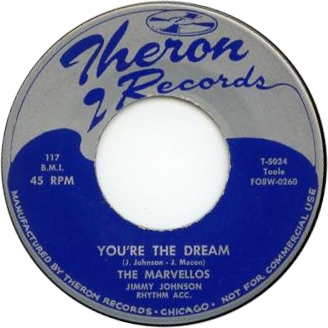
The Marvellos (vocal group) with James P. Johnson (ldr); other musicians unidentified.
RCA Victor Studios, Chicago, late 1955
| T-5024 (FO8W-0260) |
You're the Dream (J. Johnson - J. Macon) | Theron 117 | |
| T-5023 (FO8W-0261) |
Calypso Mama (J. P. Johnson - H. Duncan) | Theron 117 |
Theron 117 was a 45-rpm single issued in January 1956. According to Robert Ferlingere's Discography of Rhythm & Blue and Rock 'n Roll Vocal Groups, 1945 to 1965 (2nd edition, 1992), there are East Coast "repros" of this single on both black and red vinyl.
The Marvellos release was the last gasp for Theron Records. Toole probably saw in this doowop group an opportunity to make a dent in the new teenage rhythm and blues/rock 'n' roll market. The Billboard reviewer, in the January 28, 1956 issue, said of "You're the Dream," after giving it a lowly 67 rating, "one of those quiet and refined ballads; but the material and performance is so celestial that the disk lacks brightness or pop." The comments on "Calypso Mama" are intriguing, "This one was an attempt to get something out of the ordinary; but it succeeds in only being weird" (he gave it a 63). Cash Box's reviewer (February 4, 1956, p. 26) liked the record a little better.
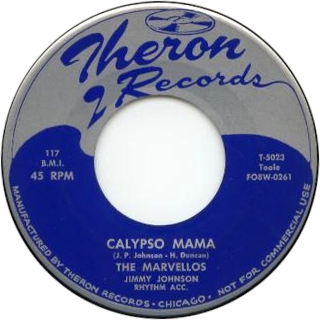
Toole apparently spent a lot of his railroad money pushing the Marvellos, a quartet that included two brothers, because he sent them on a promotional tour in January and February 1956. According to Cash Box on February 4, 1956 (p. 33), Connie Toole of Theron lending The Marvellos to distribs in East for promotion stunts." Alas, as with all of Toole's acts the record did not fulfill his dreams.
The Marvellos went on to record in January 1958 for Norman Forgue's Stepheny label (based in Evanston). They enjoyed somewhat greater commercial success with "Come Back My Love" and "Boyee Yoing" on Stepheny SF1818 (the latter title, we note, carried songwriting credits to J. P. Johnson and H. Duncan). In 1961 the Marvellos launched and gave their name to the Marvello label; the company was owned by musician James P. Johnson, who hade been in charge of the accompaniment on their Theron release and cowrote some of their songs. (We've listed Marvello in an Appendix to our King Kolax page; King Kolax was in charge of A&R for the label.) The Marvellos recorded two sides for Johnson. These were very weirdly issued in 1961 on two singles, both numbered 98-377, and split between the Marvellos on the A side and Dotty Tillman on the B side. "I Need a Girl" is a nice bouncy number that is a bit thinly produced, and "Red Hot Mama," a boring jump with good bass work. Some years after the two sides on the Marvello label, there was a reissue (on a label called Cha Cha, C756) of the Marvellos' Stepheny single.
Some information on the Marvellos was found in Galen Gart's First Pressings: The History of Rhythm and Blues, Volume 6.
There are gaps in the release series at Theron 104, 109, 110, and 116; however the T-5000 series has only one missing matrix number, T5004, which looks like a simple mistake. Our tentative conclusion: while they may have been planned, 104, 109, 110, and 116 never saw the light of day.
The Therons end at 117, but we know of two more releases that Connie Toole was responsible for.

The Vals (vocal group on * and **): David Wilkerson Jr.; Clarence Greene; Ernie Morris; Billy Gibson (lead); William Taylor (bass); Vicki Johnson (voc on **); unidentified accompaniment.
Chicago, 1961
| 1657 ARCX-253-A | *Compensation Check | Unique Laboratories no # | |
| 1658 ARCX-253-B | **I'll Get You | Unique Laboratories no # | |
| 1659 ARCX-253-C | **Bells Are Ringing | Unique Laboratories no # | |
| 1660 ARCX-253-D [?] | *The Song of a Lover | Unique Laboratories no # |
Toole's last activity in the recording business took place in 1961, when he recorded four sides: two on a vocal group, The Vals, "The Song of a Lover" and "Compensation Blues," and two on a female singer, Vicki Johnson, "Bells Are Ringing" and "I'll Get You."
The records were released on Val Hutchinson's Unique Laboratories label, but the labels indicated that they were "Produced by Theron Record Company." According to Wilkerson of the Vals only 200 copies of each were pressed up, apparently to test the waters. When nothing happened with those the Vals record was dead. The mid-1950s doowop sound of the record made it too dated for 1961. Only five copies are still known to exist. On the Vicki Johnson sides, the Vals' support is anemic and of little interest to doowop fans.
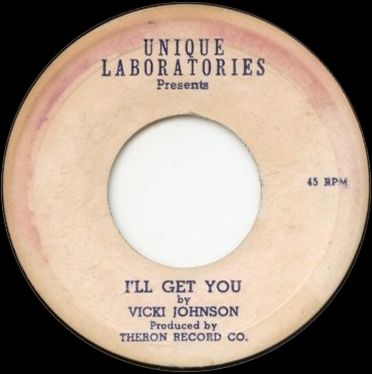
For more about the Unique Laboratories releases see Robert Stallworth, "Vals, Supreme Rarities Documented; Chance Also Home to Rare City Blues," Record Collector's Monthly, 38 (September/October, 1987).
Toole kept trying to make it in the record business until the end of his life on September 2, 1968. (His obituary ran in the Chicago Sun-Times on September 5.)
Asked if any records came out after 1961, Cornelius sadly and bitterly related
I don't remember and I doubt it. He was still struggling though. My father tried desperately to maintain the company but he just didn't have the business know-how. Many a problem with black entrepreneurs they didn't know how to work a company up to something. And then of course there was a tremendous amount of racial prejudice. It amounted to outright thievery. I'm especially concerned about the thievery. I do know a lot of things he should had credit for and he should have made money on. I heard stuff over the radio. His stuff was being played by Benson and other people. He didn't get the money.
In later years, Theron Toole was a Chicago police officer and later worked for the federal government as a fair housing investigator. Cornelius Toole, a lawyer who was an assistant state attorney, later operated a private practice, and for the last five years of his life was a judge. Along with their sister, Jewel Toole Calloway, each inherited parts of Toole's company, but apparently none of them got the master tapes.
Click here to return to Red Saunders Research Foundation page.